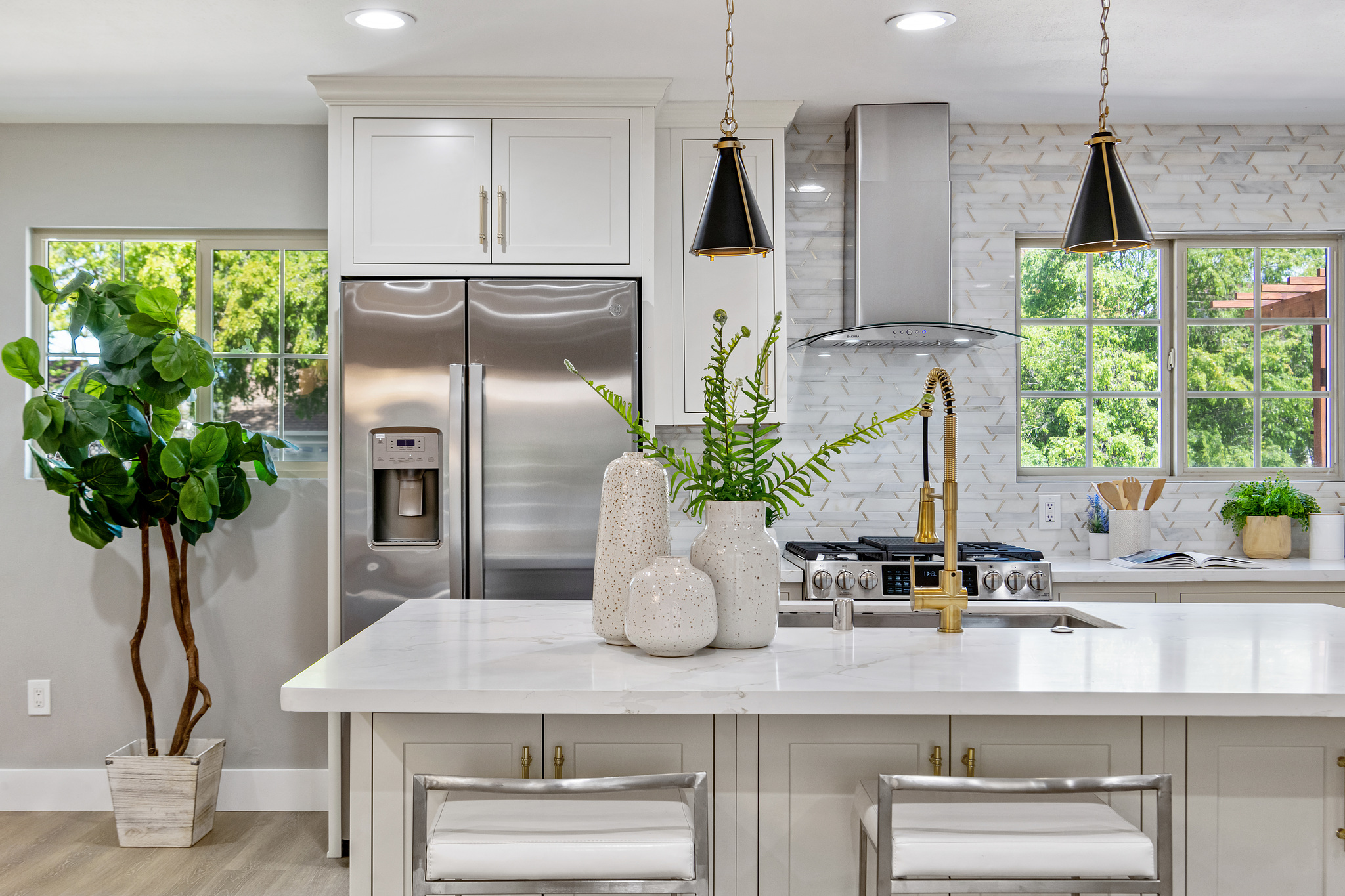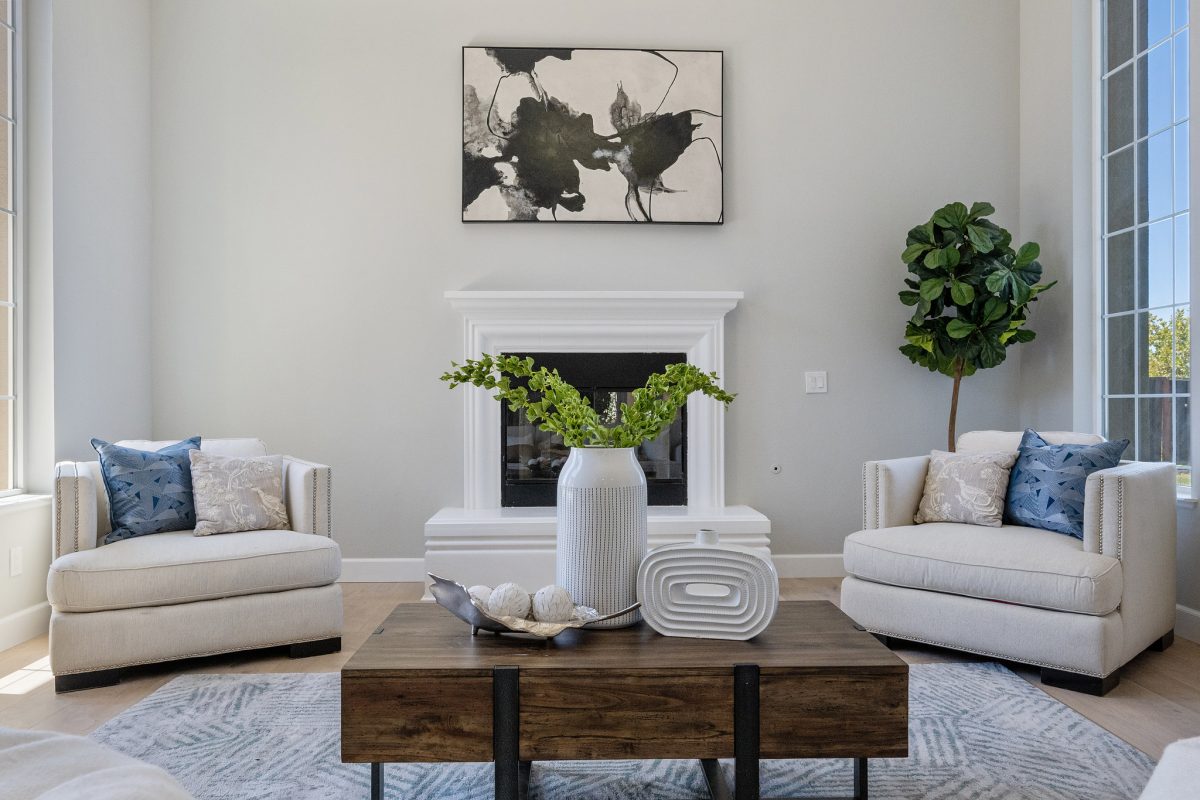
Remodel To Sell™ System for Savvy Homeowners and Aspiring Investors
I am a real estate expert who identifies key improvements that dramatically increase your home’s market appeal, without breaking the bank. My Remodel To Sell guide will show you how to unlock your home’s full potential and achieve the highest return on your investment, ensuring a seamless and profitable selling experience.
Throughout my career, I’ve consistently encountered two primary concerns from savvy homeowners looking to sell their property:
- What is the current value of my home?
- Is there anything we can do to increase its selling price?
The first question can be answered online. Almost every real estate website can provide a value range for your home, including mine.
This guide answers the second question. This is a time tested, proven strategy that gets the highest possible price when you sell your home.
Introduction To My career
Every profession has its specializations. Just as there are doctors focused on general family medicine and others on cosmetic surgery, choosing the right expert is pivotal for achieving desired outcomes. The real estate industry is no exception. There are agents skilled in assisting first-time buyers or those helping families downsize. To meet your objectives, particularly when aiming to optimize the sale price of your home, it’s crucial to collaborate with an agent experienced in that realm.
With roots in design and fashion, my passion seamlessly transitioned into the world of real estate. The opportunity to tour some of the world’s most exquisite homes is nothing short of a dream realized. My humble beginnings in Vietnam didn’t afford me the finest dolls, yet I was undeterred, crafting them beautiful dresses from the scarce resources available. Little did I realize then, that this innate knack for making the most out of the least would pave the way for a flourishing career in the real estate realm.
From the inception of my career, I was driven to master the art of achieving the best possible selling prices for my clients and for my personal investments. My ambition to transform homes from ordinary to extraordinary fueled this journey. For over 18 years, I’ve identified undervalued properties, revamped them, and then sold them at a profit.
I viewed it as a “trial by fire”. Venturing into home purchases with minimal experience to grasp the intricacies of home remodeling was indeed a risk. However, this journey has proven immensely fulfilling. It’s astounding to think I began with modest homes and condos, and now I’m flipping properties valued close to $4 million.
While the end transformation and the profit are gratifying, my primary motivation is leveraging this experience to offer unparalleled service to homeowners.
There are 3 sales concepts that you must understand for before you sell your home
First Choice Dominance (FCD)
We see FCD around us everyday with common items we buy. In the smartphone industry, a model that offers superior features, brand reputation, or user experience can dominate the market. For instance, when Apple releases a new iPhone, it often sees a surge in sales despite the presence of other comparable smartphones on the market. Fashion is another example, a particularly coveted designer item, such handbag from brands like Chanel or Hermes, can command immense market attention. These items often sell out quickly after release, with many consumers willing to wait for restocks or pay premiums on secondary markets rather than purchasing readily available alternatives from other brands.
Relating to Real Estate, FCD occurs when your property not only meets the basic requirements of potential buyers but surpasses them, becoming the most desirable option available. This could be due to aesthetic appeal, modern upgrades or simply the way the home “feels” to home buyers. Whatever the reason, a home that achieves this status doesn’t just sell; it sells quickly, often at a premium price, and sometimes with multiple offers. The other comparable homes for sale lose their desirability and home shoppers are willing to wait for another home that has all the things they want hits the market.
Capitalizing on First Choice Dominance can be a game-changer for homeowners looking to sell. This phenomenon, where certain properties garner significantly more interest and command higher prices due to their appeal, can be leveraged to maximize your home’s market potential. Here’s how homeowners can use First Choice Dominance to their advantage, ensuring their property stands out in a crowded market.
Read this to see how FCD made my listing sell for $26,000 over asking while another unit was withdrawn from the market because it did not present well:
First Choice Dominance, The Most Important Concept When Selling Your Home
Emotions sell homes. Buyers that connect with a home will buy it
It’s easy to get caught up in the numbers – square footage, number of bedrooms, price per square foot. But at the heart of every home purchase is something far less tangible and far more powerful: emotion. Buyers are not just looking for a place to live; they’re looking for a connection, a preview of how their lives could unfold in this new space.
When buyers walk through a home, they’re not just ticking off items on a checklist. They’re imagining their future. They’re picturing holiday dinners in the dining room, cozy movie nights in the living room, and peaceful mornings in the breakfast nook. They’re not just looking at the walls and floors; they’re envisioning the backdrop of their lives.
This is why it’s crucial for sellers to present their homes in a way that speaks to buyers’ emotions. Outdated lighting and fixtures can be a turn-off because they represent work that needs to be done, an obstacle to the easy, carefree life buyers are dreaming of. Instead, homes that are move-in ready, with modern amenities and inviting spaces, allow buyers to see themselves living there, enjoying their lives.
For example, a well-lit kitchen with updated fixtures and a spacious island can evoke images of entertaining friends and family, creating a sense of warmth and sociability. Similarly, a cozy, well-appointed bedroom can suggest relaxation and tranquility, appealing to buyers’ desire for a private retreat after a long day.
In essence, selling a home is not just about selling a physical structure. It’s about selling a lifestyle, a vision of the future. By highlighting the features that enable buyers to see themselves in the home, sellers can tap into the emotional aspect of the buying process, making their property not just a house, but a potential home.
So, when preparing your home for sale, remember that buyers are looking for more than just a roof over their heads. They’re looking for a place where they can live their best lives. Make sure your home tells that story, and you’ll be more likely to connect with the right buyer who is ready to make an offer.
Home Buyer Price Levels
Homebuyers typically operate within specific price ranges or ‘levels’. Some may be exploring options between the $800K and $900K bracket, while others have their sights set on homes valued between $900K and $1M. The goal for sellers is recognize where their property currently stands and then make deliberate upgrades to appeal to the higher bracket of buyers. By making these strategic enhancements, you position your home to compete effectively within a more lucrative market segment.
Example:
Let’s say we determine to list the house at $899K in the current condition. The next major price level is $919K or $929K. If you can make the entire house look and feel better by updated lighting, paint the cabinets a modern color and install new laminate flooring for $5,000, will that push the listing price to the next level?
What about a kitchen and bathroom remodel? Will spending $25,000 raise the price level to $949K or $979K?
These are questions only an experienced real estate agent can answer because they know what has sold and what the other homes for sale in the same price levels look like.
We are not trying to make a few extra thousand dollars for specific items, we are trying to spend the least amount of money to reach the higher price levels. This strategy can lead to massive price increases.
Don’t think that spending $1,000 on a new front door will result in a higher sales price of $2,000. Remodeling to sell does not work like that.
Buyers don’t just commit to a home because of its luxurious front door or brand-new appliances. They’re captivated by the emotions a home evokes. When house-hunting, they imagine themselves in that space: hosting get-togethers or nurturing a family. As a real estate agent championing your property, I steer conversations towards these aspirational visions with prospective buyers. At every open house, I ensure there’s ample food and beverages in the home’s natural gathering spot, facilitating relaxed, friendly interactions. It’s during these moments that one can truly discern when a home’s ambiance resonates with a potential buyer.
Emotions are beyond valuation. Every individual’s vision of a “Dream Home” is unique. This is why a home priced at $800K can evoke emotions as profound as one in a higher price bracket. The ultimate aim is to refine a home in a way that it consistently evokes unparalleled feelings of joy and contentment.
Homes with heftier price tags may simply be bigger or newer, but they don’t necessarily elicit those deep emotional connections for the buyer. Large homes that were amazing in 1980 will not show well today. Homes are often listed based on square feet, but to buyers they just see added expenses in order to make that home their own.
Before we dive into the system, let’s go over a few myths.
Myth #1. Buyers would rather remodel after they buy
Myth:
This myth has been created by all the home improvement shows like “Fixer Upper” and “Property Brothers”. I love watching those shows too but things on TV are not necessarily the ways things work in the real world. Contrary to the popular belief that homebuyers prefer purchasing fixer-uppers to customize them to their liking, the reality paints a different picture. A majority of buyers struggle to visualize the potential of an unfinished space. Consequently, homes that are already well-presented and finished are more attractive to the majority of purchasers.
Truth:
In reality, most homebuyers seek a hassle-free experience. The dual challenge of purchasing a home and then embarking on a potentially stressful remodeling process — with all its inconveniences — is far from appealing. Many buyers gravitate towards homes that already exude a sense of warmth and comfort, even if some of their “dream” features are amiss. The allure of immediate livability often outweighs the desire for customization, and many are willing to invest more for a home that’s move-in ready.
Myth #2. Takes Too Much Time
Myth:
A commonly held belief among sellers is that the process of remodeling a home for sale is too time-consuming and cumbersome. This myth propagates the idea that it’s more efficient and lucrative to quickly list the home as-is, bypassing any renovation efforts, in order to expedite the selling process.
Truth:
The fact is that leveraging a seasoned real estate team, equipped with ready-to-go contractors and a proficient project manager, can streamline the remodeling process significantly. Such teams excel in making accurate time estimations and are committed to adhering to a predetermined completion date. Additionally, they possess in-depth knowledge of the real estate market’s rhythms. This enables them to strategically adjust project timelines, ensuring that the house is listed during peak selling periods when properties often command higher prices.
Myth #3. It’s not worth the cost to remodel
Myth:
A pervasive sentiment among homeowners is that remodeling prior to selling is not financially judicious. This stems from the fear that the costs of renovation will not be recouped in the sale price, leading to a diminished return on investment and potential financial losses.
Truth:
It’s a misconception to believe that all remodeling efforts won’t yield a positive return on investment. The key lies in targeted renovations: focusing on areas of the home that buyers genuinely value. When homeowners prioritize updates in spaces that buyers consistently demonstrate a willingness to pay a premium for, the return on investment can be substantial. The most informed guidance on which areas to focus on comes from seasoned real estate teams. With their extensive experience working with myriad buyers, they have a keen understanding of which home features are truly coveted and which ones can be sidelined.
The Benefits Outweigh The Risks
Higher Selling Price:
Strategic remodeling enhances a property’s appeal, increasing its market value. Modernized spaces attract buyers, leading to higher offers and a more profitable sale.
Shorter Time on Market
Homes that have been updated and refreshed tend to attract buyers more quickly, resulting in fewer days on the market. A property that aligns with buyer preferences often experiences accelerated sales, minimizing the wait for sellers. Remember time is money!
Less Problems During Escrow
Remodeled homes often face fewer inspection issues, ensuring a smoother escrow process. Addressing potential issues beforehand reduces buyer renegotiations and delays, facilitating a faster and more straightforward transaction.
You Gain Experience
Understanding the process for a remodeling project equips homeowners with practical insights into property enhancement. This firsthand experience can pave the way for potential ventures in property flipping or confidently embarking on future home renovations.
Remodel To Sell Action Plan
- 1
Understand the market
The first step in developing a pricing strategy is to conduct a comprehensive analysis of the local real estate market. We’ll look at data on recent sales and current listings to get a sense of what similar properties are selling for in the area. - 2
Set a Baseline Value For Your Specific Home
Based on the market analysis and your property’s features, we’ll set a realistic and competitive price in its current condition. This price will determine how much profit can be made with strategic updates. - 3
Consider Upgrade Options
In a competitive market, pricing the property slightly below market value could attract more buyers and result in multiple offers. Alternatively, if the property has highly sought-after amenities or is in a desirable location, pricing it higher could lead to a quicker sale at a higher price - 4
Determine Time, Cost and Lifestyle Concerns
It’s important to be open to feedback from potential buyers and their agents. If you’re not receiving the level of interest you had hoped for, we’ll consider adjusting the price or marketing approach to better align with market demand
Understanding the Real Estate Market.
In the real estate world, there’s a perpetual cycle of doubt: buyers and homeowners frequently hold back, anticipating a ‘better’ market. But there’s always a challenge to face.
For instance, when interest rates are low, buyers find themselves in fierce competition, often grappling with multiple offers and homes selling above their listed prices. Conversely, when home prices skyrocket, they become unaffordable.
For homeowners, the dilemma is different but equally perplexing. As prices climb, the temptation is to wait, hoping to cash in at an even higher value. Yet, when the market reaches its zenith and prices begin to decline, they hesitate to sell, fearing they’ve entered a ‘bad’ market. The reality is, in real estate, there’s seldom a universally perfect moment to act.
In each situation, when you immerse yourself in the real estate world, you’ll realize it’s all about perspective. The broader market’s fluctuations might not impact you as directly as you think. If you’re selling your home, the good news might be that it’s highly valued; the flip side is that you’ll likely be purchasing in a similarly priced market. This phenomenon is often termed the ‘property ladder’. Historically, ascending this ladder has been a proven method to build lasting wealth for both you and future generations.
To discern whether you’re navigating a buyer’s or seller’s market, it’s pivotal to engage in thorough research. Begin by analyzing the current inventory of homes: a surplus might indicate a buyer’s market, while scarcity could signal a seller’s advantage. Next, investigate the average duration properties remain on the market. Shorter listing durations typically correlate with high demand. Furthermore, examining the discrepancy between listing prices and final sale prices can offer insights into bidding trends. Are homes frequently selling over their asking price, or are they often negotiated down? Lastly, keep an eye on broader economic indicators and real estate trends, like mortgage rates and new housing starts, as they can provide context for your selling strategy
While a sellers market is always better to sell in, a home that has been properly updated and hits all the right buyer buttons will outperform all other homes that are for sale
Set a Baseline Value For Your Specific Home
Pricing a home appropriately is a delicate balance, driven by comprehensive market analysis. Comparative home sales, commonly known as “comps,” play a pivotal role in this process. Understanding their pricing can help position your property competitively.
While a good real estate agent gathers data from recently sold, pending, and active properties around your home’s vicinity, a top-notch agent goes a step further by contacting agents of pending homes. Even though the exact selling price of a pending home remains confidential until it’s finalized, agents can provide valuable insights such as:
- Number of Offers: This can indicate the level of interest and competition for homes in the area. This also indicates that there are active buyers in the area, many are now frustrated and will have higher interest in buying the next house that is available. This is a perfect scenario to bring a home to the market that has all the updates the buyers are looking for.
- Buyer Feedback: Agents often share general feedback from potential buyers, which can shed light on property desirability or possible improvements.
- Specific Buyer Comments: Were there any particular aspects of the home that buyers frequently commented on, either positively or negatively? This feedback can be invaluable for sellers to understand the unique selling points or areas of improvement in their property
- Duration on the Market: How long the property was available before going under contract can signal the market’s pace and demand.
- Concessions: Details about any seller concessions, like paying for closing costs or including appliances, which might have been necessary to seal the deal.
- Comparative Differences: Highlighting features or shortcomings in the pending home as compared to others on the market can provide perspective on what buyers are valuing.
- Market Trends: Any shifts or patterns the agent has noticed in recent times, be it an increase in cash buyers, a surge in investment purchases, or a preference for turnkey homes.
- Buyer Demographics: Getting a sense of who the buyers are – families, young professionals, retirees – can help in tailoring a marketing approach.
Gathering these insights empowers a homeowner to make more informed decisions regarding pricing, marketing strategies, and potential home improvements to make the property more appealing to potential buyers.
Online home valuation tools offer a convenient way to get an initial estimate of your property’s worth. However, it’s crucial to approach these figures with caution. While they may provide a ballpark value, these tools often don’t consider the unique and specific features of the homes, potentially missing nuances that could impact its true market value. They serve as a helpful starting point, but for a more comprehensive and accurate assessment, a professional evaluation is indispensable. When you’re prepared to delve deeper into your property’s value, we’re here to offer a precise pricing report that meticulously factors in your home’s distinct attributes.
By synthesizing information from these three categories, coupled with an evaluation of your home’s unique features and amenities, we can determine an accurate and strategic baseline price for your property.
homeowners can take numerous steps to enhance the value of their property, but several external factors that can influence home value remain beyond their control. Here are some of those factors:
- Location: Often the adage “location, location, location” holds true. The proximity to amenities, quality schools, public transport, shopping centers, and other facilities can greatly impact value. On the other hand homes near loud train tracks
- Economic Conditions: The broader health of the economy, including employment rates and economic stability, can affect housing demand and, consequently, property values.
- Interest Rates: Changes in interest rates can impact a buyer’s ability to secure a mortgage, which in turn affects demand and property values.
- Property Taxes: Higher taxes in a particular area can deter potential buyers, potentially driving down home values.
- Crime Rates: Areas with high crime rates tend to have lower property values. Safety and security are top priorities for most buyers.
- Future Development Plans: If there are plans for a new landfill, factory, or even a commercial complex, it might affect the desirability of nearby homes. On the other hand, the addition of parks, schools, or shopping centers can boost values.
- Natural Disasters: Regions prone to natural disasters like floods, earthquakes, hurricanes, or wildfires might see their property values affected due to higher insurance costs and risks associated with living there.
- Overall Market Conditions: The cyclical nature of the real estate market – whether it’s a buyer’s, seller’s, or balanced market – can influence what a property is worth at any given time.
- Neighborhood Condition and Upkeep: The maintenance and condition of nearby properties and the neighborhood can influence a home’s value. A well-maintained neighborhood will typically uphold property values better than one in decline.
- Historical Sales: Recent sales of comparable properties (comps) in the area set a precedent for what buyers are willing to pay.
Understanding these factors can help homeowners set realistic expectations about their property’s value, even as they make improvements to enhance its appeal.
Inspections
To understand the base value it’s highly recommended to determine if there are any major unseen problems with the home by getting the property inspected.
Termite Report
This is a specialized inspection that exclusively targets wood-destroying pests and organisms. It’s not limited to just termites but also includes other pests like beetles and fungi that might cause wood rot. The report will often categorize issues into two sections.
- Section 1: Active infestations or conditions causing damage now.
- Section 2: Conditions that might lead to future infestations or damage.
When buying or selling a home, it’s common for lenders or buyers to request that Section 1 issues be resolved before closing the deal. Section 2 items, on the other hand, are often seen as recommendations, and addressing them might not be mandatory for the sale, but they’re important for the long-term care of the property.
Property Inspection Report:
A property inspection report is a comprehensive assessment of a property’s overall condition. It is conducted by a qualified property inspector who examines various elements of the home to ensure they are in good working order and to identify potential problems.
Areas typically covered in a property inspection include:
- Structural Elements: Examination of walls, ceilings, floors, roof, and foundation to ensure they’re sound.
- Systems: Checking the functionality of major systems like heating, cooling, plumbing, and electrical.
- Appliances: Evaluation of appliances to ensure they are operational.
- Roofing: Checking for leaks, age, and overall condition of the roof.
- Exteriors: Looking at doors, windows, and any potential issues with siding or paint.
- Basements and Attics: Checking for water intrusion, mold, insulation, and adequate ventilation.
- Safety Issues: This can include checks for asbestos, mold, or radon detection.
The goal of a property inspection is to provide potential buyers with a clear understanding of the home’s current condition, ensuring there aren’t any surprise issues after purchase.
It is always advisable to get these reports as soon as possible. You do not want to spend thousands of dollar on improvements only to find major problems after an offer has been accepted and the home is in contract. These problems will frighten the buyers and most likely they will cancel the sale, ask for a heavy discount or request that the problem is fixed before close of contract.
Consider Upgrade Options
A common misconception among homeowners venturing into property renovation for sale is a direct, itemized return on investment. They might believe, for instance, that investing $1,000 in a lavish front door will directly boost their property’s value by $2,000. However, this perspective is misguided. The true key to maximizing returns lies not in isolated improvements but in a holistic approach. To truly elevate the property’s value, one must consider the entire home and devise a comprehensive strategy aimed at pushing the property into a superior price bracket.
Owning a home offers the wonderful opportunity to tailor it to your personal tastes. However, as years go by, every pink room painted for a newborn or every replaced faucet due to wear and tear can lead to a mix of styles. To boost value effectively, it’s wise to unify and standardize the home’s aesthetic. These are very low cost solutions that have the biggest impact on selling price.
The Holistic Approach To Increase Positive Emotions
We approach updating a home in levels of complexity and return on investment.
The first renovation level deals with “normal family operations,” it’s important to address areas that need simple updates to enhance its appeal to potential buyers. These simple updates that have the highest impact for a normal house and in our opinion must be taken care of.
The second renovation level moves beyond basic cosmetic updates to more significant renovations can dramatically increase a home’s appeal and potentially its sale price. These next-level updates involve more substantial investments in both time and money but can significantly transform your home’s appearance and functionality.
The third renovation level involves the most complex and expensive projects. Typically involve full kitchen remodels or removing walls. These extensive renovations can significantly transform a home’s appeal, functionality, and market value. However, it’s crucial to approach such major investments strategically, ensuring they align with the overall condition and style of the home to maximize return on investment.
This is the “fixer” type of home. Many owners decide to sell as-is because they do not have the funds for the project. Later in this guide we show you that funds are available and any project can get done.
Remember, while it’s essential to modernize and improve the home’s aesthetic, it’s equally important to ensure the changes resonate with the target market in your area. What’s popular and sought after in one region may not be the same in another, so always consider local preferences and trends.
When preparing a home for sale, it’s essential to understand that not all renovations and updates will offer a good return on investment. Some changes might not resonate with buyers or may not increase the property’s overall value.
Here are several updates that buyers often don’t prioritize and might not be willing to pay extra for:
When preparing a home for sale, it’s essential to understand that not all renovations and updates will offer a good return on investment. Some changes might not resonate with buyers or may not increase the property’s overall value. Here are several updates that buyers often don’t prioritize and might not be willing to pay extra for:
- Overly Personalized Renovations: Custom designs that are tailored to specific tastes, like niche hobby rooms or unique color schemes, might not appeal to the general market.
- Luxury Upgrades: High-end amenities, such as a sauna or wine cellar, might not resonate with all buyers, especially if such features are uncommon in the neighborhood.
- Complicated Landscaping: While a well-maintained garden is a plus, overly intricate landscaping might be seen as high maintenance and deter some buyers. Observe the neighborhood landscape styles. New lawns look great and in most cases improve price, if water prices are high that’s added expense that buyers will consider when making an offer.
- Wall-to-Wall Carpeting: Many modern buyers prefer hardwood or tile floors because they’re easier to clean and seen as more hygienic.
- Swimming Pools: In certain areas, a pool can be seen as an unnecessary expense and maintenance hassle rather than a luxury, especially in regions where it can’t be used year-round.
- Over-the-Top Home Theaters: While a bonus room is a draw, converting it into a dedicated theater room might not recoup costs, as not all buyers prioritize this.
- Converted Garages: Some homeowners convert garages into living spaces, but many buyers still value a secured space for vehicles and storage.
- Extensive Security Systems: While basic home security features are valued, a complex, expensive system may not add significant value unless the property is in a high-end market where such systems are standard.
- Sunrooms: While they can be a lovely addition, they might not offer a high return on investment in comparison to other home improvements.
- Unusual Appliances: Specialized or uncommon kitchen appliances might not appeal to the general buyer who may prioritize standard, well-known appliances.
It’s worth noting that regional preferences can play a significant role. What’s deemed unnecessary in one area might be highly valued in another.
Buyer Assumptions: Home Areas That Must Be in Good Working Condition
When it comes to selling a home, certain features and areas may not directly contribute to a higher sale price if upgraded or in pristine condition, yet their poor state can significantly deter potential buyers. Understanding these aspects can help sellers prioritize maintenance and repairs to avoid negative impressions. Here are several key areas where this principle applies:
- Roof: As mentioned, while a new roof might not increase the offer price, a damaged or aging roof can lead to concerns about leaks and potential water damage, making buyers hesitant.
- HVAC System: Buyers typically expect the heating, ventilation, and air conditioning (HVAC) systems to be in good working order. Although a brand-new system might not fetch a higher price, an old or malfunctioning system can be a red flag for buyers, worrying them about future replacement costs and discomfort.
- Plumbing: Modern, high-end plumbing fixtures won’t necessarily drive up the price, but issues like leaks, old pipes, or poor water pressure can turn buyers off. Plumbing problems suggest potential for significant future expenses and inconvenience.
- Electrical System: An updated electrical system won’t always add value in the eyes of a buyer, but outdated wiring, insufficient capacity, or safety hazards like exposed wires can be major concerns, implying risk and potential investment to upgrade.
- Foundation: Buyers are unlikely to pay extra for a home simply because it has a solid foundation—this is expected. However, signs of foundation issues, such as cracks in walls or uneven floors, can significantly deter offers due to fears of major structural repairs.
- Windows: High-quality, energy-efficient windows might not be a major selling point unless they’re part of broader energy-saving features of the home. However, old, drafty windows can be a turnoff, signaling to buyers that they might face high utility bills and the need for an expensive upgrade.
- Pest-Free Environment: The presence of pests or signs of infestation won’t add value if absent but will certainly decrease a home’s appeal and can be a deal-breaker for many buyers, who may worry about health concerns and the cost of extermination and repairs.
- Cleanliness and Odor-Free: While a spotlessly clean home with fresh smells might not increase an offer, the opposite – a dirty home with bad odors (such as pet smells or cigarette smoke) – can drastically reduce buyer interest. It suggests poor maintenance and the need for deep cleaning or renovation.
By ensuring these areas are in good condition, sellers can prevent potential deal-breakers and make their home more appealing to a wide range of buyers, facilitating a smoother sale process.
The Final Touch: Staging
Staging is the art of preparing and presenting a home in its best possible light to appeal to the broadest range of potential buyers. It’s about creating an environment where buyers can easily imagine themselves living. This often involves a mix of decluttering, depersonalizing, decorating, and optimizing the space to enhance its functionality and appearance.
When a home is free of apparent issues and is also clean, staging adds the final touch that can make it irresistible. Here’s why:
- First Impressions: Just as one might dress up for an important interview, a home should make a strong first impression. Staging ensures that when a potential buyer walks in, their initial reaction is positive and lasting.
- Emotional Connection: By presenting a home in a neutral yet inviting manner, staging allows buyers to visualize their life in the space. It transforms a property from just a building into a potential home.
- Perceived Value: A well-staged home can appear well-maintained and cared for, which can lead buyers to perceive it as more valuable than a comparable un-staged property.
- Space Optimization: Staging showcases the potential of every square foot. Whether it’s turning a small nook into a cozy reading space or arranging furniture to improve flow, staging helps buyers see the possibilities.
- Distract from Flaws: No home is perfect, but staging can help divert attention away from minor flaws and focus on the home’s positive attributes.
Statistics on Home Staging:
- Enhanced Sale Price: According to NAR, 22% of sellers’ agents reported an increase of 1% to 5% of the dollar value offered by buyers for staged homes compared to similar un-staged homes. Some saw even more substantial increases.
- Quicker Sale: NAR also reported that homes staged before listing sold on average 87% faster than un-staged ones.
- Buyer’s Perception: In the same NAR study, 83% of buyers’ agents said staging made it easier for buyers to “visualize” the property as a future home.
Top Rooms to Stage: Living rooms, primary bedrooms, and kitchens were found to be the most crucial areas to stage.
Determine Time, Cost and Lifestyle Concerns
To determine whether a specific upgrade is worthwhile, one must weigh more than just its cost. It’s crucial to consider the scale and duration of the project in relation to your personal needs. Will this renovation necessitate relocating temporarily, or could it be wrapped up within a day? Key questions to guide this decision include: How disruptive will the project be to your routine? How much stress might it introduce? What’s the projected time frame? Answering these can help you make an informed decision on which improvements are feasible and beneficial, ensuring a smoother transition into that desired higher price level.
Ways to Pay For The Updates
We offer up to $1,500 that can be used towards the project. This does not have to be paid back. This is my gift to you because I have a reputation for bringing high quality homes to market with very few problems. Other agents know this and love working with me.
I have also found that for a normal 3 bed, 2 bath home, $1,500 allows for a huge improvement. The work can be completed very quickly. The most common updates are fresh paint, new lighting, new fixtures and hardware. These simple, cost effective updates will raise the selling price the most..
For larger projects you have a few options
- Out of pocket. You pay the contractors as the work is completed.
- Pay at closing. I finance the project and the final cost is paid after closing and the new buyers have moved in. There is no interest accrued no matter how long the house is on the market.
- Home Equity Loan: This is a loan against the equity built up in your home. It typically offers lower interest rates compared to personal loans or credit cards.
- Home Equity Line of Credit (HELOC): Similar to a home equity loan, a HELOC provides a line of credit based on your home’s equity, but it functions more like a credit card with a revolving balance.
Buy You next home first and then sell
- Bridge Loans: These short-term loans can help homeowners who are looking to purchase a new property before selling their current one. The funds can be used to finance renovations to enhance the old property’s market value.
- Loan Recasting: Loan recasting, or re-amortizing, is a lesser-known option for homeowners. It allows borrowers to apply a large, lump-sum payment toward their principal balance and then have the loan re-amortized – that is, recalculated based on the new, lower balance.
To Move Forward or Not
We have reached the conclusion. Now things get interesting. I’m sure you’ve made significant decisions in your life before, but this time we’re talking about doing something that could generate a lot of money and build your family’s wealth. You have all the information you need to decide whether or not you are ready to proceed.
- You did research and you know what type of real estate market you are currently in, either a buyer or seller market.
- Your property has been inspected and we have a termite section #1 report that shows what needs to be fixed in order to close.
- We have your home’s baseline home value.
- I have contacted other agents with recent pending in the area and know what to expect and what demographic is most likely to buy your home.
- We create a strategy whether we update or not. We establish a cost, timeline and personal impact on your lifestyle.
Always consider all your avenues. Even if you believe you could fetch a higher price for your home but anticipate financing challenges or personal obstacles, solutions exist. Consult a professional to understand the available options.

Follow us
A quick overview of the topics covered in this article.
- First Choice Dominance (FCD)
- Emotions sell homes. Buyers that connect with a home will buy it
- Home Buyer Price Levels
- Before we dive into the system, let’s go over a few myths.
- The Benefits Outweigh The Risks
- Understanding the Real Estate Market.
- The Holistic Approach To Increase Positive Emotions
- Buyer Assumptions: Home Areas That Must Be in Good Working Condition
- The Final Touch: Staging
- Ways to Pay For The Updates








